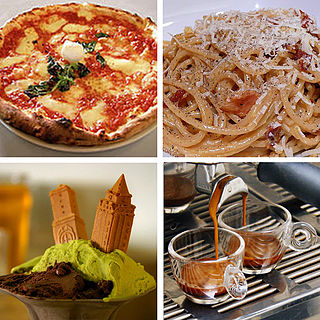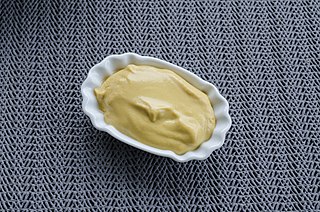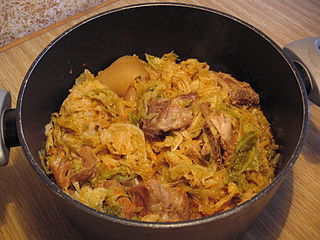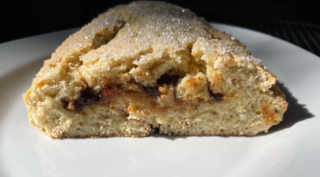
A condiment is a preparation that is added to food, typically after cooking, to impart a specific flavor, to enhance the flavour, or to complement the dish. A table condiment or table sauce is more specifically a condiment that is served separately from the food and is added to taste by the diner.

Piacenza is a city and comune (municipality) in the Emilia-Romagna region of Northern Italy, and the capital of the eponymous province. As of 2022, Piacenza is the ninth largest city in the region by population, with more than 102,000 inhabitants.

Marzipan is a confection consisting primarily of sugar and almond meal, sometimes augmented with almond oil or extract.

Peperoncino is the generic Italian name for hot chili peppers, specifically some regional cultivars of the species Capsicum annuum and C. frutescens. The sweet pepper is called peperone in Italian. Like most peppers, the fruit is green or yellowish-green when young, and ripens to a red color.

A relish is a cooked and pickled culinary dish made of chopped vegetables, fruits or herbs and is a food item typically used as a condiment to enhance a staple. Examples are chutneys and the North American relish, a pickled cucumber jam eaten with hot dogs. In North America, the word "relish" is frequently used to describe a single variety of finely chopped pickled cucumber relish, such as pickle, dill and sweet relishes.

Confit is any type of food that is cooked slowly over a long period as a method of preservation.

Almond paste is made from ground almonds or almond meal and sugar in equal quantities, with small amounts of cooking oil, beaten eggs, heavy cream or corn syrup added as a binder. It is similar to marzipan, but has a coarser texture. Almond paste is used as a filling in pastries, but it can also be found in chocolates. In commercially manufactured almond paste, ground apricot or peach kernels are sometimes added to keep the cost down.

Italian cuisine is a Mediterranean cuisine consisting of the ingredients, recipes and cooking techniques developed in Italy since Roman times and later spread around the world together with waves of Italian diaspora. Some of these foods were imported from other cultures. Significant changes occurred with the colonization of the Americas and the introduction of potatoes, tomatoes, capsicums, maize and sugar beet—the latter introduced in quantity in the 18th century. It is one of the best-known and most appreciated gastronomies worldwide.

A crostata is an Italian baked tart or pie. The earliest known use of crostata in its modern sense can be traced to the cookbooks Libro de Arte Coquinaria by Martino da Como, published c. 1465, and Cuoco napolitano, published in the late 15th century, containing a recipe titled Crostata de Caso, Pane, etc..
More or less distinct areas in medieval Europe where certain foodstuffs dominated can be discerned. In the British Isles, northern France, the Low Countries, the northern German-speaking areas, Scandinavia and the Baltic the climate was generally too harsh for the cultivation of grapes and olives. In the south, wine was the common drink for both rich and poor alike while beer was the commoner's drink in the north and wine an expensive import. Citrus fruits and pomegranates were common around the Mediterranean. Dried figs and dates occurred quite frequently in the north, but were used rather sparingly in cooking.

Spaghetti aglio e olio is a pasta dish typical of the Italian city of Naples. It is a typical dish of Neapolitan cuisine and is widely popular. Its popularity can be attributed to it being simple to prepare and the fact that it makes use of inexpensive, readily available ingredients that have long shelf lives in a pantry.

Italian meal structure is typical of the European Mediterranean region and differs from Northern, Central, and Eastern European meal structure, though it still often consists of breakfast (colazione), lunch (pranzo), and supper (cena). However, much less emphasis is placed on breakfast, and breakfast itself is often skipped or involves lighter meal portions than are seen in non-Mediterranean Western countries. Late-morning and mid-afternoon snacks, called merenda, are also often included in this meal structure.

Mustard is a condiment made from the seeds of a mustard plant.

Lombard cuisine is the style of cooking in the Northern Italian region of Lombardy. The historical events of its provinces and of the diversity of its territories resulted in a varied culinary tradition. First courses in Lombard cuisine range from risottos to soups and stuffed pasta, and a large choice of second course meat or fish dishes, due to the many lakes and rivers of Lombardy.

A food paste is a semi-liquid colloidal suspension, emulsion, or aggregation used in food preparation or eaten directly as a spread. Pastes are often highly spicy or aromatic, are often prepared well in advance of actual usage, and are often made into a preserve for future use. Common pastes are some fruit preserves, curry pastes, and nut pastes. Purées are food pastes made from already cooked ingredients.

Campanino, also known as mela modenese, transl. Modenese apple, or mela della nonna, transl. grandmother's apple, is a variety of the domestic apple. Thanks to its long shelf life, the Campanino has been popular not only in Italy but also in export to countries such as Germany.

The pinza bolognese is a dessert that comes from the Bolognese peasant tradition, which was generally prepared during the Christmas holidays, even if it is now consumed all year round. The recipe appears for the first time in 1644 in the volume L'economia del cittadino in villa by Vincenzo Tanara.
















